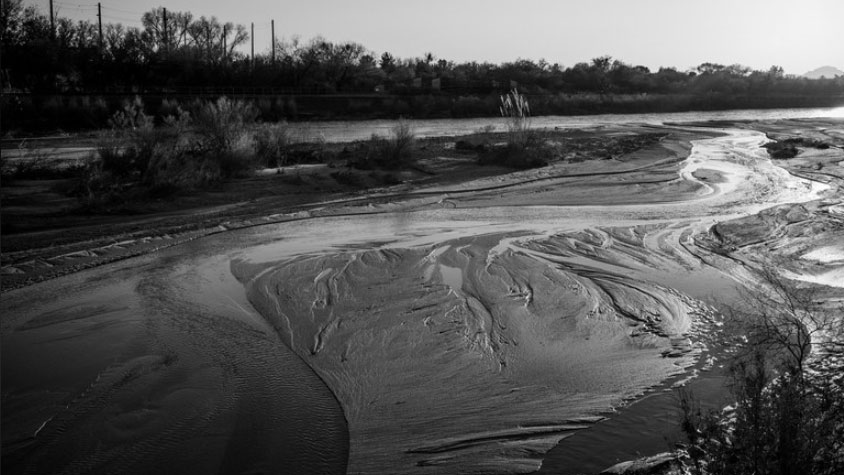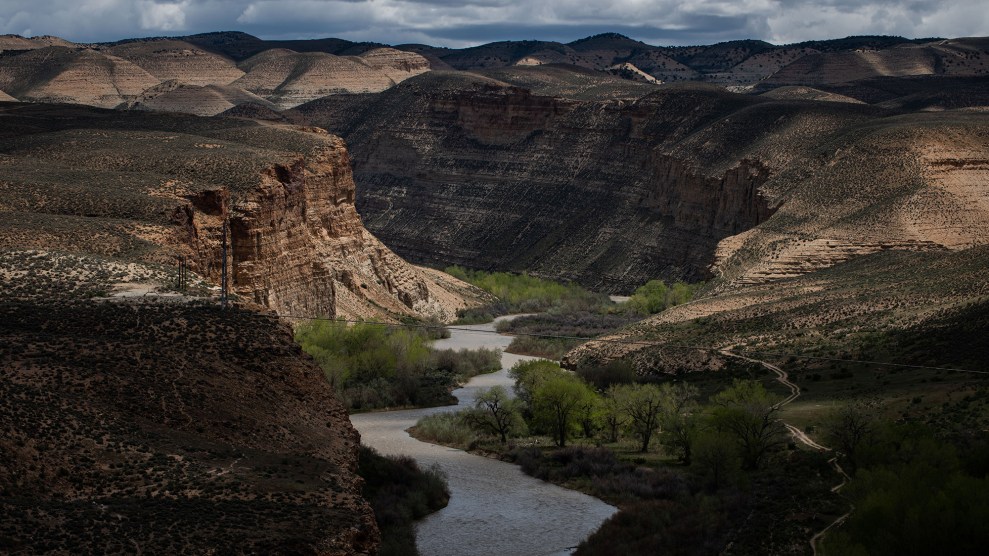
The Rillito in Tucson, Arizona, is an ephemeral stream that carries water only just after the annual snowmelt. Nearly all Arizona streams are ephemeral or intermittent, and many lost federal protections as a result of the Supreme Court's Sackett ruling.Roberto (Bear) Guerra/High Country News
This story was originally published by High Country News and is reproduced here as part of the Climate Desk collaboration.
Like icebergs and human beings, waterways are made up of more than what’s visible on the surface. Take Lapwai Creek, near Lewiston, Idaho: At a casual glance, it’s a ribbon of cool water, shaded by cottonwood trees and alive with steelhead and sculpin, mayfly and stonefly larvae. An adult could wade across it in a few strides without getting their knees wet. But that’s just the part people can see. Beneath the surface channel, coursing through the rounded cobbles below, is what scientists call the hyporheic zone: water flowing along underground, which can be a few inches deep, or 10 yards or more, mixing with both surface water and groundwater. Microbes that purify water live down there, and aquatic insects—food for fish and other animals—can use it as a sort of underground highway, traveling more than a mile away from a river.
A creek, in other words, is more than just the water in its channel; it’s also the water underground, and it’s connected to everything else in its watershed, including wetlands and channels upstream that might dry up during some years, or perhaps go years between getting wet. Whatever happens there—pollution or protection—happens to the entire creek. In the case of Lapwai Creek, which flows into the Clearwater River and then the Snake River, it’s a small but fundamental part of the complex ecosystem that salmon, humans and countless other creatures in the Pacific Northwest rely on.
But those ecological realities are strikingly absent from last week’s US Supreme Court decision in Sackett v. EPA. The ruling strips federal protections from all ephemeral streams and, as reported by E&E News, more than half of the previously protected wetlands in the US. It limits Clean Water Act protections to “relatively permanent, standing or continuously flowing bodies of water.” That includes some wetlands—those that are “indistinguishable” from protected oceans, lakes, rivers and streams “due to a continuous surface connection.”
“It doesn’t reflect reality, or the scientific understanding of how watersheds and the river networks within them function,” said Ellen Wohl, a river researcher and professor in the Geosciences Department at Colorado State University. Wohl helped review the scientific evidence used to develop an earlier, and much more expansive, Obama-era definition of which bodies of water fall under the jurisdiction of the Clean Water Act.
The act itself says it covers “the waters of the United States,” often abbreviated WOTUS, but what exactly that means has been the subject of decades of litigation and conflicting rule-making by federal administrations. In this decision, the Supreme Court took up the question in the context of a lawsuit Michael and Chantell Sackett brought against the Environmental Protection Agency in 2008. The case concerned whether or not there were protected wetlands on a property the couple owns near Priest Lake, Idaho. If there were, the Sacketts would have needed to get a Clean Water Act permit before filling the lot with dirt, and would now owe the agency hefty fines for having filled it without one; if there weren’t, then they could proceed with building a house on the lot without the permit.
All nine Supreme Court justices agreed that there were no protected wetlands on the property. And five of them—Justices Samuel Alito, John Roberts, Clarence Thomas, Neil Gorsuch and Amy Coney Barrett—went further. The majority opinion, written by Alito, focused in part on defining the word “adjacent”—as in, wetlands adjacent to protected waterbodies—to mean inseparable. That’s a stricter interpretation of the law, and leaves more wetlands unprotected, than any definition put forth by a federal administration since 1977, including the Trump administration’s 2020 rule. The remaining four justices spell that out in a concurring opinion, written by Justice Brett Kavanaugh: “The Court’s ‘continuous surface connection’ test disregards the ordinary meaning of ‘adjacent.’ … As a result, the Court excludes wetlands that the text of the Clean Water Act covers—and that the Act since 1977 has always been interpreted to cover.”
In addition to wetlands, the decision excludes many—or perhaps most, or even all; the ruling is unclear—temporary streams. These include ephemeral streams, which flow only after snow- or rainfall—such as flooding desert washes — and intermittent ones, which sometimes go dry, often seasonally, like the Rio Grande in New Mexico.
Temporary streams and rivers exist primarily in the arid West, particularly in the Great Plains and the Great Basin. And they’re important for both ecosystems and humans: According to EPA data, 70 percent of the miles of streams supplying public water systems that more than 3 million people in Arizona’s Maricopa County relied on in 2009 were ephemeral or intermittent. In fact, 96 percent of Arizona’s total stream mileage is ephemeral or intermittent; New Mexico, too, has very few relatively permanent waterways. “So, arguably, (nearly) all the rivers and streams in those two states are no longer protected by the Clean Water Act,” said Mark Ryan, a retired EPA lawyer who specialized in the act and represented the EPA in the Sackett case until he left the agency in 2014.
That “arguably” is important. It’s now up to the EPA to interpret the ruling and define what exactly “relatively permanent” means, because the majority opinion itself is silent on the matter. In fact, it doesn’t mention intermittent or ephemeral streams at all, though it does say, in reference to protected waters, that “temporary interruptions in surface connection may sometimes occur because of phenomena like low tides or dry spells.” The phrases “temporary interruptions” and “dry spells” seem to leave the door open for protecting some intermittent streams, but the absence of details—like how long of a dry spell is acceptable—leaves the matter up to agency rules, and litigation over them.
Weaker protections mean that more wetlands and temporary streams will be destroyed, filled in with dirt for houses or other development. Ecosystems and people alike will lose the benefits they provide: biodiversity and abundance of species; space to absorb extra water during storms, preventing deadly floods; natural storage of that same water, so it’s available later, during dry times; the natural purification that occurs when water is filtered through the ground.
Take, for example, a desert playa in the Great Basin, which might be dry for years at a time. When rainwater falls on it or snowmelt flows into it, it acts like “a big sponge,” Wohl said. A sponge that can store water for later, and clean it, too. But if you turn it into a parking lot by filling or building on it, as the Supreme Court ruling makes it easier to do, water will pour off it, rather than soak in. And what was once a playa—part of an intricate system changing across space and time—will become simply an asphalt wasteland.












